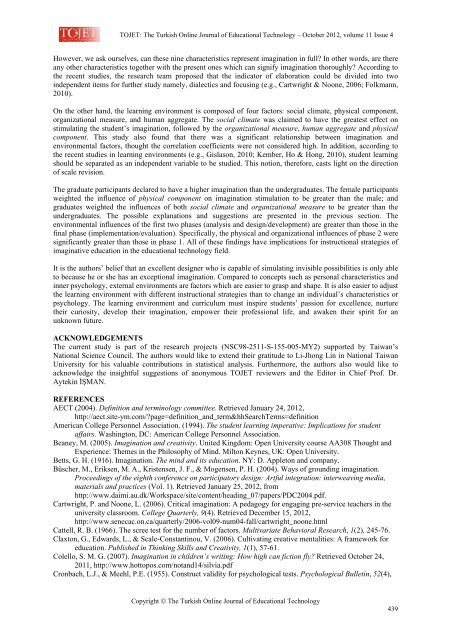october 2012 - TOJET the Turkish online journal of educational ...
october 2012 - TOJET the Turkish online journal of educational ...
october 2012 - TOJET the Turkish online journal of educational ...
Create successful ePaper yourself
Turn your PDF publications into a flip-book with our unique Google optimized e-Paper software.
<strong>TOJET</strong>: The <strong>Turkish</strong> Online Journal <strong>of</strong> Educational Technology – October <strong>2012</strong>, volume 11 Issue 4<br />
However, we ask ourselves, can <strong>the</strong>se nine characteristics represent imagination in full? In o<strong>the</strong>r words, are <strong>the</strong>re<br />
any o<strong>the</strong>r characteristics toge<strong>the</strong>r with <strong>the</strong> present ones which can signify imagination thoroughly? According to<br />
<strong>the</strong> recent studies, <strong>the</strong> research team proposed that <strong>the</strong> indicator <strong>of</strong> elaboration could be divided into two<br />
independent items for fur<strong>the</strong>r study namely, dialectics and focusing (e.g., Cartwright & Noone, 2006; Folkmann,<br />
2010).<br />
On <strong>the</strong> o<strong>the</strong>r hand, <strong>the</strong> learning environment is composed <strong>of</strong> four factors: social climate, physical component,<br />
organizational measure, and human aggregate. The social climate was claimed to have <strong>the</strong> greatest effect on<br />
stimulating <strong>the</strong> student’s imagination, followed by <strong>the</strong> organizational measure, human aggregate and physical<br />
component. This study also found that <strong>the</strong>re was a significant relationship between imagination and<br />
environmental factors, thought <strong>the</strong> correlation coefficients were not considered high. In addition, according to<br />
<strong>the</strong> recent studies in learning environments (e.g., Gislason, 2010; Kember, Ho & Hong, 2010), student learning<br />
should be separated as an independent variable to be studied. This notion, <strong>the</strong>refore, casts light on <strong>the</strong> direction<br />
<strong>of</strong> scale revision.<br />
The graduate participants declared to have a higher imagination than <strong>the</strong> undergraduates. The female participants<br />
weighted <strong>the</strong> influence <strong>of</strong> physical component on imagination stimulation to be greater than <strong>the</strong> male; and<br />
graduates weighted <strong>the</strong> influences <strong>of</strong> both social climate and organizational measure to be greater than <strong>the</strong><br />
undergraduates. The possible explanations and suggestions are presented in <strong>the</strong> previous section. The<br />
environmental influences <strong>of</strong> <strong>the</strong> first two phases (analysis and design/development) are greater than those in <strong>the</strong><br />
final phase (implementation/evaluation). Specifically, <strong>the</strong> physical and organizational influences <strong>of</strong> phase 2 were<br />
significantly greater than those in phase 1. All <strong>of</strong> <strong>the</strong>se findings have implications for instructional strategies <strong>of</strong><br />
imaginative education in <strong>the</strong> <strong>educational</strong> technology field.<br />
It is <strong>the</strong> authors’ belief that an excellent designer who is capable <strong>of</strong> simulating invisible possibilities is only able<br />
to because he or she has an exceptional imagination. Compared to concepts such as personal characteristics and<br />
inner psychology, external environments are factors which are easier to grasp and shape. It is also easier to adjust<br />
<strong>the</strong> learning environment with different instructional strategies than to change an individual’s characteristics or<br />
psychology. The learning environment and curriculum must inspire students’ passion for excellence, nurture<br />
<strong>the</strong>ir curiosity, develop <strong>the</strong>ir imagination, empower <strong>the</strong>ir pr<strong>of</strong>essional life, and awaken <strong>the</strong>ir spirit for an<br />
unknown future.<br />
ACKNOWLEDGEMENTS<br />
The current study is part <strong>of</strong> <strong>the</strong> research projects (NSC98-2511-S-155-005-MY2) supported by Taiwan’s<br />
National Science Council. The authors would like to extend <strong>the</strong>ir gratitude to Li-Jhong Lin in National Taiwan<br />
University for his valuable contributions in statistical analysis. Fur<strong>the</strong>rmore, <strong>the</strong> authors also would like to<br />
acknowledge <strong>the</strong> insightful suggestions <strong>of</strong> anonymous <strong>TOJET</strong> reviewers and <strong>the</strong> Editor in Chief Pr<strong>of</strong>. Dr.<br />
Aytekin İŞMAN.<br />
REFERENCES<br />
AECT (2004). Definition and terminology committee. Retrieved January 24, <strong>2012</strong>,<br />
http://aect.site-ym.com/?page=definition_and_term&hhSearchTerms=definition<br />
American College Personnel Association. (1994). The student learning imperative: Implications for student<br />
affairs. Washington, DC: American College Personnel Association.<br />
Beaney, M. (2005). Imagination and creativity. United Kingdom: Open University course AA308 Thought and<br />
Experience: Themes in <strong>the</strong> Philosophy <strong>of</strong> Mind. Milton Keynes, UK: Open University.<br />
Betts, G. H. (1916). Imagination. The mind and its education. NY: D. Appleton and company.<br />
Büscher, M., Eriksen, M. A., Kristensen, J. F., & Mogensen, P. H. (2004). Ways <strong>of</strong> grounding imagination.<br />
Proceedings <strong>of</strong> <strong>the</strong> eighth conference on participatory design: Artful integration: interweaving media,<br />
materials and practices (Vol. 1). Retrieved January 25, <strong>2012</strong>, from<br />
http://www.daimi.au.dk/Workspace/site/content/heading_07/papers/PDC2004.pdf.<br />
Cartwright, P. and Noone, L. (2006). Critical imagination: A pedagogy for engaging pre-service teachers in <strong>the</strong><br />
university classroom. College Quarterly, 9(4). Retrieved December 15, <strong>2012</strong>,<br />
http://www.senecac.on.ca/quarterly/2006-vol09-num04-fall/cartwright_noone.html<br />
Cattell, R. B. (1966). The scree test for <strong>the</strong> number <strong>of</strong> factors. Multivariate Behavioral Research, 1(2), 245-76.<br />
Claxton, G., Edwards, L., & Scale-Constantinou, V. (2006). Cultivating creative mentalities: A framework for<br />
education. Published in Thinking Skills and Creativity, 1(1), 57-61.<br />
Colello, S. M. G. (2007). Imagination in children’s writing: How high can fiction fly? Retrieved October 24,<br />
2011, http://www.hottopos.com/notand14/silvia.pdf<br />
Cronbach, L.J., & Meehl, P.E. (1955). Construct validity for psychological tests. Psychological Bulletin, 52(4),<br />
Copyright © The <strong>Turkish</strong> Online Journal <strong>of</strong> Educational Technology<br />
439
















